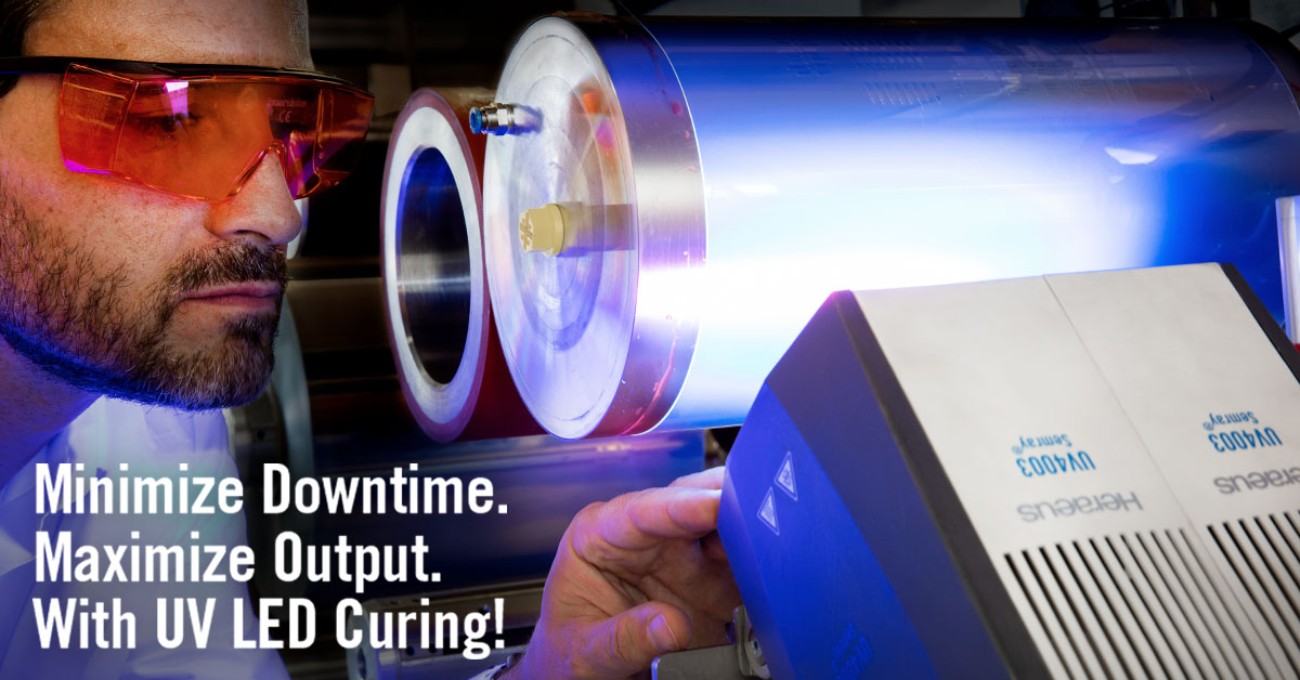Before we discuss how UV LED curing reduces downtime, it’s important to acknowledge that each converting UV curing process, while similar to others, has unique requirements and parameters based on many factors such as the substrate, specific chemistry, web speed and width, etc.
So it’s important as you embark on your UV LED process development journey to find partners, both equipment and chemistry, who can help guide and support you along the way. You’ll need partners who have experience with
lab testing, and pilot line or in-plant trials
.
The good news is that UV curing testing, when done correctly in the lab, easily scales to pilot line and production processes.
Now on to reducing downtime with UV LED curing.

Top 3 Ways UV LED Curing Reduces Downtime
Currently available UV LED curing technology offers many advantages for converting processes such as laminating adhesives (paper-to-film, film-to-film, film-to-foil), hydrogels and others where longer wavelength, deep curing is important. The most interesting advantage for process design and development engineers is the opportunity to reduce downtime compared to existing medium pressure arc lamp UV curing processes.
This deep dive will help you gain a better understanding of the impact for your converting process.
Every process is unique

Factors that contribute to reduced downtime
Compared to traditional arc lamp UV curing systems, UV LED curing systems can significantly reduce downtime. Let’s discuss how each factor contributes to downtime reduction.

It’s no secret that the useful (able to still effectively cure) operating life of arc lamps is short, ranging from 1,000 hours on average and up to 4,000 hours under optimal conditions. Additive (“doped”) lamps, which are typically used for most laminating adhesive curing applications, have an even shorter useful operating life. And without proper lamp cooling (iron additive, sometimes called D lamps are particularly sensitive to temperature), or if your process stops and starts often, then you likely experience, and design for, even shorter useful operating hours.
In contrast, a UV LED lamp can easily reach a useful lifetime of 10,000 hours and may reach 20,000 hours depending on plant conditions and process curing parameters. So, on average a production line has to stop every 1,000 operating hours to replace the arc lamp and probably more often for additive lamps. UV LED lamps need to be replaced 10 to 20 times less often!
That results in significantly less downtime for lamp changes.
When there is a LED array failure, some UV LED systems offer a plug and play feature that makes replacing an array very quick – literally seconds instead of as much as 30 minutes or more to replace an arc lamp.
Arc UV curing lamps require a startup time of about 3 to 5 minutes to reach full output. And then when the line stops, it takes time to restrike the lamp because it has to cool down. As a result, most arc systems use shutters to avoid this lamp restrike time during line stoppages.
The shutter not only adds to system cost, but also introduces another component to maintain or possibly fail unexpectedly (more downtime).
UV LED curing systems can turn on/off instantly without the need for shutters and without reducing lamp life. Production lines typically integrate the control of the UV LED curing system so that if the line stops the lamp shuts off instantly so as not to damage the substrate, and then start/restart instantly when the line starts/restarts.
UV LED curing reduces downtime associated with warm-up, say at the start of a shift or shift turnover, and production line stops/restarts due to other production process needs.

Arc UV curing systems have many components that require frequent maintenance including bulbs, shutters, reflectors, ballasts, and cooling and exhaust fans. It’s recommended to clean lamps, reflectors and shutters every 500 operating hours. And since most wide web converting lines use longer arc lamps, there’s also the need to rotate lamps once a week to avoid bending or bowing of the lamp. This lamp bowing, if not addressed, shortens the operating life and may affect reliability of the curing process.It’s also recommended to change reflectors with every lamp change.
There’s also maintenance of the cooling and exhaust fans and filter changes.
All this maintenance time results in downtime. If your converting production process currently uses arc lamps for UV curing, you can gather actual maintenance data to compare to a UV LED system for new process development consideration.
UV LED system maintenance is significantly less since there is no shutter, reflector, or ballast, and essentially maintenance-free cooling fans.
The quartz emission window, the working end of the UV LEDs next to the substrate, does require cleaning anywhere from once a week for dirty environments to every 4 weeks for clean environments. This can typically be done without removing the unit. Cooling air filters should be cleaned and reused or replaced as needed. But in most cases, this is a quick procedure because it doesn’t require removing the units from the production line, and filters need cleaning less often than arc lamp systems because the cooling air volume is so much less.
Most commercial production lines using UV LED systems simply integrate their maintenance into the routine cleaning and service of other equipment on the converting line so that it doesn’t cause any significant additional downtime.
UV LEDs reduce downtime

Based on the factors just discussed, most converting production lines that replace arc lamps with UV LED curing systems will reduce downtime from 10% to 50% or more. UV LED system manufacturers can help you assess the potential reductions for your converting lines based on their recommended maintenance practices, equipment design, and your specific processes. Once you have an estimate of reduced downtime you can easily calculate increased production rates or yield possible with UV LED curing.
Learn more about Improving Converting Curing Processes with UV LED Curing .
